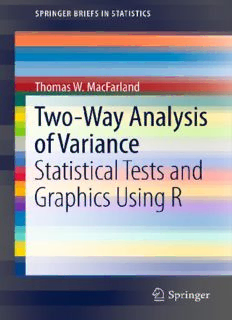Table Of ContentSpringerBriefs in Statistics
Forfurthervolumes:
http://www.springer.com/series/8921
Thomas W. MacFarland
Two-Way Analysis
of Variance
Statistical Tests and Graphics Using R
123
ThomasW.MacFarland
OfficeforInstitutionalEffectiveness
NovaSoutheasternUniversity
FortLauderdale,FL,USA
[email protected]
ISSN2191-544X e-ISSN2191-5458
ISBN978-1-4614-2133-7 e-ISBN978-1-4614-2134-4
DOI10.1007/978-1-4614-2134-4
SpringerNewYorkDordrechtHeidelbergLondon
LibraryofCongressControlNumber:2011943305
©Thomas W. MacFarland 2012
Allrightsreserved.Thisworkmaynotbetranslatedorcopiedinwholeorinpartwithoutthewritten
permission of the publisher (Springer Science+Business Media, LLC, 233 Spring Street, New York,
NY10013, USA),except forbrief excerpts inconnection with reviews orscholarly analysis. Usein
connectionwithanyformofinformationstorageandretrieval,electronicadaptation,computersoftware,
orbysimilarordissimilarmethodologynowknownorhereafterdevelopedisforbidden.
Theuseinthispublicationoftradenames,trademarks,servicemarks,andsimilarterms,eveniftheyare
notidentifiedassuch,isnottobetakenasanexpressionofopinionastowhetherornottheyaresubject
toproprietaryrights.
Printedonacid-freepaper
SpringerispartofSpringerScience+BusinessMedia(www.springer.com)
Contents
1 LearnRwithSampleLessonsinEd ucationandtheSocial
Sciences,Health,andtheBiologicalSciences............................. 1
1.1 PurposeofTheseLessons .............................................. 1
1.2 BackgroundonR........................................................ 2
1.3 BackgroundonTwo-WayANOVA .................................... 2
1.4 OrganizationofTheseLessons......................................... 4
1.4.1 DataImportorDataEntry .................................... 4
1.4.2 DataOrganization............................................. 4
1.4.3 DisplaytheCodeBook ....................................... 5
1.4.4 ConductaVisualDataCheck................................. 5
1.4.5 DescriptiveAnalysisoftheData ............................. 5
1.5 DetailsoftheThreeSampleDatasets.................................. 6
1.5.1 Tab-SeparatedASCIIFile..................................... 6
1.5.2 FixedWidth–FixedColumnASCIIFile ..................... 6
1.5.3 Comma-SeparatedValuesASCIIFile........................ 6
2 Two-Way Analysis of Variance (ANOVA) Sample 1:
ComparisonofScoresonaFinalExaminationbyTeaching
MethodandbyStatusasaCommunityCollegeGraduate.............. 9
2.1 DataImportofa.txtTab-DelimitedDataFileintoR ................. 10
2.1.1 DataImportorDataEntry .................................... 11
2.2 OrganizetheDataandDisplaytheCodeBook........................ 11
2.3 ConductaVisualDataCheck .......................................... 15
2.3.1 SimplePlots ................................................... 15
2.3.2 HistogramoftheSummaryObjectVariable................. 16
2.3.3 Horizontal and Vertical Boxplots
oftheSummaryObjectVariable.............................. 17
2.3.4 Sorted Dot Chart of the SummaryObject
VariablebyBreakoutObjectVariables....................... 18
2.3.5 HistogramoftheSummaryObjectVariable
byBreakoutObjectVariables................................. 19
v
vi Contents
2.4 DescriptiveAnalysisoftheData....................................... 21
2.4.1 SummaryDescriptiveStatistics............................... 22
2.4.2 BreakoutDescriptiveStatistics ............................... 23
2.5 UseRforTwo-WayAnalysisofVariance(ANOVA)................. 25
2.5.1 Two-WayANOVA:aov()Function........................ 26
2.5.2 OutcometoSample1 ......................................... 27
3 Two-Way Analysis of Variance (ANOVA) Sample 2:
Comparison of Systolic Blood Pressure Readings by
Self-DeclaredSmoking Habits and by Self-Declared
DrinkingHabits.............................................................. 31
3.1 Data Importof a .prnFixed Width–FixedColumn
(e.g.,Space-Separated)FormatDataFileintoR ...................... 33
3.1.1 DataImportorDataEntry .................................... 35
3.2 OrganizetheDataandDisplaytheCodeBook........................ 37
3.3 ConductaVisualDataCheck .......................................... 44
3.3.1 SimplePlots ................................................... 44
3.3.2 HistogramoftheSummaryObjectVariable................. 45
3.3.3 Horizontal and Vertical Boxplots of the
SummaryObjectVariable..................................... 47
3.3.4 HistogramoftheSummaryObjectVariable
byBreakoutObjectVariables................................. 48
3.3.5 DensityPlotoftheSummaryObjectVariable
byBreakoutObjectVariables................................. 50
3.3.6 Boxplotof the Summary Object Variable
byBreakoutObjectVariables................................. 51
3.4 DescriptiveAnalysisoftheData....................................... 53
3.4.1 SummaryDescriptiveStatistics............................... 53
3.4.2 BreakoutDescriptiveStatistics ............................... 54
3.5 UseRforTwo-WayAnalysisofVariance(ANOVA)................. 60
3.5.1 Two-WayANOVA:aov()Function........................ 60
3.5.2 s20xPackage .................................................. 62
3.5.3 OutcometoSample2 ......................................... 63
4 Two-Way Analysis of Variance (ANOVA) Sample 3:
ComparisonofLarvaeCountsbyAgChemFormulation
andbyAgChemApplicationTime-of-Day................................ 69
4.1 DataImportofa.csvSpreadsheet-TypeDataFileintoR............. 71
4.1.1 DataImportorDataEntry .................................... 72
4.2 OrganizetheDataandDisplaytheCodeBook........................ 72
4.3 ConductaVisualDataCheck .......................................... 78
4.3.1 SimplePlots ................................................... 78
4.3.2 HistogramoftheSummaryObjectVariable................. 79
4.3.3 Horizontal and Vertical Boxplots
oftheSummaryObjectVariable.............................. 84
4.3.4 ViolinPlotoftheSummaryObjectVariable................. 86
Contents vii
4.3.5 BeanplotoftheSummaryObjectVariable................... 88
4.3.6 Quantile–Quantile(Q–Q)PlotoftheSummary
ObjectVariable................................................ 89
4.3.7 Sorted Dot Chart of the SummaryObject
VariablebyBreakoutObjectVariables....................... 90
4.3.8 HistogramoftheSummaryObjectVariable
byBreakoutObjectVariables................................. 91
4.3.9 DensityPlotoftheSummaryObjectVariable
byBreakoutObjectVariables................................. 95
4.3.10 Boxplotof the Summary Object Variable
byBreakoutObjectVariables................................. 97
4.3.11 HorizontalandVerticalBoxplotsoftheSummary
ObjectVariablebyBreakoutObjectVariables............... 98
4.3.12 VerticalViolinPlotsoftheSummaryObject
VariablebyBreakoutO bjectVariables....................... 100
4.3.13 Beanplotsofthe SummaryObjectVariable
byBreakoutObjectVariables................................. 102
4.3.14 RepresentationofGroupMeansandConfidenceIntervals.. 103
4.3.15 PlotBreakoutObjectValuesonaContinuum
oftheSummaryObjectVariable.............................. 106
4.4 DescriptiveAnalysisoftheData....................................... 114
4.4.1 SummaryDescriptiveStatistics............................... 115
4.4.2 BreakoutDescriptiveStatistics ............................... 117
4.4.3 ContingencyTables ........................................... 124
4.5 UseRforTwo-WayAnalysisofVariance(ANOVA)................. 126
4.5.1 Two-WayANOVA:aov()Function........................ 126
4.5.2 AdditionalRPackagesthatSupportTwo-WayANOVA.... 128
4.5.3 OutcometoSample3 ......................................... 130
4.5.4 ConsiderationoftheDatafromaNonparametric
Perspective..................................................... 136
4.5.5 OptionalHousekeepingatEnd-of-Session................... 137
Chapter 1
Learn R with Sample Lessons in Education
and the Social Sciences, Health,
and the Biological Sciences
Abstract R was developed in the early- to-mid 1990s and it has developed into
a robust open source software environment,used with multiple operating systems
for the organization, statistical analysis, and graphical presentation of data. As
presentedin this chapter,this set of lessons providesan introductionto the use of
R andemphasizesgoodprogrammingpracticesfordata importordata entry,data
organization,developmentofadetailedcodebook,visualdatachecks,descriptive
analyses,andselectedinferentialanalyses.Two-wayanalysisofvariance(ANOVA)
is the selected inferential test emphasized in this set of lessons, given how two-
way ANOVA is well-suited to investigations that examine factorial designs that
modelcomplexreal-worldproblemswith practicalapplications.This chapter also
introduces the multiple ways datasets are organized for use by R: tab-separated
ASCII files, fixed width–fixed column ASCII files, and comma-separated values
ASCIIfiles.Throughoutthesediscussions,graphicaldisplays,andotheractionsthat
relatetoqualityassurancepracticesreceivecontinualreinforcement.
1.1 PurposeofTheseLessons
This set of lessons has been developed to take advantage of R and the many
featuresavailable throughthis extensiveand expandingopen source environment.
Thepurposeofthissetoflessonsistoprovidedirectionalguidance,withgraphical
reinforcement, for those who wish to use R to examine data, conduct statistical
analyses,andpresentfindingsingraphicalformat.
Along with instruction on the use of R and R syntax associated with Two-
Way analysis of variance (ANOVA), these lessons will also reinforce the use of
descriptivestatisticsandgraphicalfigures,tocomplementoutcomesfromtwo-way
ANOVA. With attention to these lessons as well as other available resources, an
interested studentor beginningresearcher should be able to use R to conductand
graphicallydisplaysimpletocomplexstatisticalanalyses.TheRusercommunityis
growing,forgoodreason.Rworks,Risfree,andRisfairlyeasytolearn.
T.W.MacFarland,Two-WayAnalysisofVariance:StatisticalTestsandGraphics 1
UsingR,SpringerBriefsinStatistics1,DOI10.1007/978-1-4614-2134-4 1,
©Thomas W. MacFarland 2012
Description:In statistics, analysis of variance (ANOVA) is a collection of statistical models used to distinguish between an observed variance in a particular variable and its component parts. In its simplest form, ANOVA provides a statistical test of whether or not the means of several groups are all equal,

